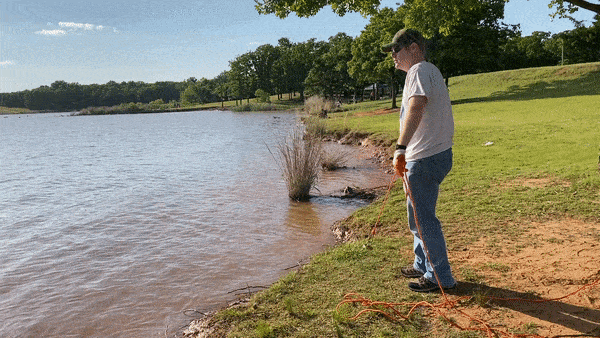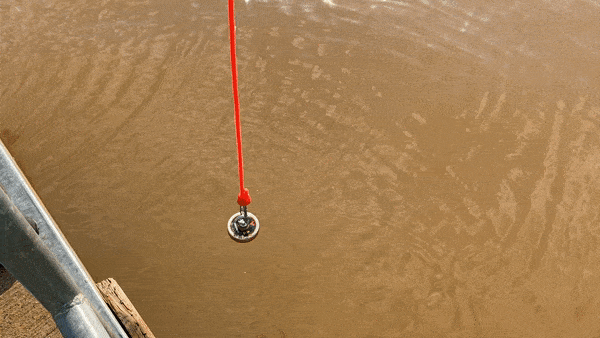
Magnet fishing is a hobby that is quickly increasing in popularity with good reason. This activity is a great way to enjoy some peaceful quite time outdoors or can be a unique experience for families.
There is not a lot of activities similar to magnet fishing and even thought it is a simple activity there are a few things to keep in mind when starting this hobby. We have compiled a list of 15 tips, tricks, and suggestions for anyone looking to have a great time while magnet fishing. Some of these topics are discussed in more detail here.
1. Get the Right Magnet Type
If you’re going to take the time and effort to go magnet fishing, you will want to ensure you get the correct type of magnet. It is easy to walk into any super store and pick up a magnet from the hobby isle. However, this will only result in frustration and very minimal finds.
You will want to purchase a Neodymium magnet, also known as “rare earth” magnets. These are super powerful with extremely high pull forces. You will need this power to retrieve almost anything you encounter. You will also need to ensure that whatever magnet you get has an eyelet so it can be attached to a rope. This is standard for most magnet fishing kits on the market today.
These are also a few dangers when using these extremely powerful magnets. Fingers can get pinched or broken, electronics can get destroyed, and there is even the chance of sharp, flying, metal shards. These dangers can easily be avoided as long as the proper precautions are taken. If you would like to learn more about these dangers and how to stay safe, check out our other article on the dangers of magnet fishing.
2. Use the Proper Knot
Just like traditional fishing, there is always the danger of losing your equipment every time you deploy your magnet. The bottom surface of any body of water is littered with organic material and debris. Items can become lodged against this debris, making retrieval difficult.
Your knot is traditionally the weakest point of your rope, provided the rope is not frayed or otherwise damaged. It would be a shame to lose your magnet due to a failed knot. You will want to make sure that a good knot is used on your magnet as well as your safety end.
Here is a great helpful video on how to tie a very common and strong knot.
3. Rope Matters
Magnet fishing involves only 2-3 pieces of equipment, all of which are equally important. This is true of not only the actual reclamation of items, but also in ensuring your magnet does not join the items lost on the bottom.
There are several types of ropes available for purchase and included in magnet fishing kits. Each type has its own strengths and weaknesses. Most kits will either come with a nylon rope or one made of parachord.
Parachord is very light, durable, and strong. However it typically smaller, which will lead to sacrificed comfort over the long run. There are also many different types of paracord of varying quality. It is mildew resistant and can withstand a lot of punishment.
Nylon is a little heaver than paracord but stretches a little under tension. This can be helpful in loosening up items buried under sediment. It is also mildew resistant and can also withstand a lot of abuse.
Our choice is the nylon rope as its pros outweigh the cons.
4. Gloves
There are several positives to the use of gloves when deploying your magnet. Choosing to proper type will save you a lot of headache and mess.
The first thing to consider when purchasing gloves is puncture resistance. You will want to grab a pair that can protect your hands from everything from fish hooks to rusty nails. You never know what you will find so protecting your hands is important.
Another thing you will want in a glove is good water resistance. You will be constantly pulling on a water soaked rope. You will also be grabbing the wet magnet as well as anything attached to it.
Finally the stuff on the bottom of a lake or river is just nasty and slimy. Gloves will keep you from having to come in contact with the sludge you bring to the surface.
5. Apparel Considerations
Dress for the occasion. This seems like an obvious point, however I wish someone had pointed it out to me before I embarked on my first magnet hunting adventure.
Consider wearing some waterproof shoes or boots. You will be around and sometimes standing in water. Also consider where you will be hunting and decide if some sort of snake protection might be a good idea. You can purchase boots or even snake guards.
Choosing the right pants is also a tip I wish was shared with me a long time ago. I remember getting into the car after my first few outings and my pants were soaked. I didn’t even get in the water, but the magnet and finds drip. The rope is also wet and will come in contact with your pants at some time.
Sometimes a little water on your clothing may be beneficial for cooling down on a hot day. Other times it can cut your hunt short. Plan accordingly.
6. Choose the Right Location
Choosing a location for finding items in a murky body of water is ultimately a guessing game. Luck also plays a huge factor in the success of any hunt. However, there are a few places to look for to up your chances.
Always look for places that have a lot of visitors. Narrow down this location by zeroing in on hot spots where people congregate. You are looking for areas where people get really close to the water or actually into it. Swimming beaches and popular fishing spots are great examples of these types of locations.
Also look for places where people get on and off boats. There are numerous types of docs for this purpose. Some docs are designed for people to step on and off boats. Other docs are for the deployment of these aquatic transports, and yet others are for storage of the boat when not in use. All are great places to hunt.
Also look for bridges and piers. Basically you are looking for anywhere people have a chance to drop or throw something in the water. We have a list of the top 11 places to magnet fish that you can read here.
7. Pros/Cons of Single Sided Magnets
For purposes of this section the term single sided magnet will refer to a magnet that has only one side exposed and the other side is attached to the rope. These are typically less expensive than the double sided ones for as you are not paying for the other magnet.
A single sided magnet is great for deploying off docks and piers. This magnet type works best when you are able to deploy straight down (techniques will be discussed later in this article).
When deploying by throwing and retrieving this type of magnet does ok. When you are pulling the magnet back to shore, it will be dragging the bottom of the lake from the top, or the non magnetic side. Any items that are directly in front of your retrieval path have the potential to being skipped over.
However, you can combat this negative by pulling slowly, the shear strength of the magnet can help in this case. If you pull over a metal object and it is not picked up due to the fact that the non magnetic leading edge hit it, you still have the potential to allow the magnet’s strength to do the job.
This type of magnet also has a good chance of picking up items that are not directly in your retrieval path. By pulling slowly, you will allow the pull force of the magnet to attract to items off to the side.
8. Pros/Cons of Double Sided Magnets
A double sided magnet is as it sounds, a magnet with two sides. Just its single sided cousin, the double sided magnet is typically attached to the retrieval chord via an eye bolt. However, this is usually done via the side instead of the top. These types of magnets tend to be more expensive.
The double sided variety is better suited for throwing and retrieving but can still work for dropping. However, when dropping this type of magnet you can never be sure that the magnetic surface of the magnet is sitting on the bottom of the water way.
One negative about this type of magnet is the fact that it does not allow for catching of items that are off to one side or the other of your retrieval path. This is due to the fact that most of the time, as you drag this magnet back to shore, one side of the magnet will be point straight down, and the other straight up.
9. Deployment and Retrieval Techniques
We use two different types of deployment and recovery techniques on our hunts. Determining which to use is very simple and usually the choice is made for us based on location.
For areas where you are forced to fish from the shore line, the throw and pull technique is most likely your only option. This technique is as simple as it sounds. Throw your magnet out into the water, wait and let it sink to the bottom, then slowly pull it back in.

After you retrieve you magnet, throw it back out again, only this time at a slight different angle. repeat until you have worked every angle you can from your launch point.
The drop technique is a simply dropping your magnet straight down from a pier or dock, letting it sink to the bottom. Once it hits the bottom, pull it up a little bit and move over, letting it sink again. Continue bouncing your magnet off the bottom until you have worked the whole area or until you connect with a target.

10. Loctite is a Must
Loctite can save you so many headaches, include the biggest one of all, loosing your magnet. Your magnet is being drug across the bottom, twisting and turning an uncountable amount of times throughout your hunt.
Just like any other screw type device, these threads have a way of working themselves loose over time. This could eventually lead to your magnet coming off somewhere at the bottom of the lake.
Using Loctite is a great way to prevent this from happening. Simply use it as a glue to hold the threads of the eye bolt to your magnet.
11. Be Pateint
As with all hobbies of this type, a lot of luck is involved in finding good items. With magnet fishing, this can be said of finding any items at all.
We have embarked on a few trips where we spent hours at a site that should have been a hot spot for lost items, only to find nothing, and when I say nothing, I mean not even a fish hook type of nothing. You will probably have these experiences also.
Don’t give up, as the opposite can be true as well. There are several videos on the internet showing people finding all sorts of items. Sometimes these items are grouped together resulting in a great day. It is only a matter of time before you find something good, be patient.
12. Be Methodical
When you really stop and think about what could be down under the surface of any water way, you are left with endless possibilities. Some items can be huge, like an old safe. Others, jewelry for example, can be very small. Obviously smaller items are easier to miss.
You should always be methodical in your approach to your hunt. It could be tempting to throw your magnet out, like you were fishing. Try a spot here, then try another spot there. However, this approach could lead to many items not being recovered.
Have a plan in place and work your plan as you deploy. Start on one side and slowly work your way to the other. Perhaps you want to start in the middle and work to one side, then come back and work the other. The plan can be made to whatever you want, just make sure you have one and you stick to it.
13. Be Realistic
We all dream of throwing our magnet out into a river and snagging one of Jesse James’ lost treasure chests filled with gold. However, the odds of this happening are so low they are almost non existent.
You can find lots of good stuff while magnet fishing, but you want to keep your expectations realistic. Most hunts will result in finding a few pieces of scrap metal or some fishing equipment. Some will yield nothing at all.
There is still the chance though, that you can find something really cool or valuable while engaged in this hobby. The thrill of the hunt is what keeps most of us in the game.
14. Practice
This may sound really strange and you may ask how and why should I practice. The answer is simple, just like any other hobby you want to get to know your equipment and how it performs before you embark on a magnet fishing adventure.
You will want to know your magnet feels when it connects to something metallic. You, after all, will be holding a rope and your magnet will not be visible to you. You don’t want to keep working your magnet across the bottom if you have something already attached. Knowing that feeling will help you determine the best time to pull your magnet out of the water.
You will also want to know how your rope handles and how your carabiners work if you are using them. Knowing the best way to lay your rope out before you toss it into the water can save you some time and frustration. Also nothing is worse than thinking your safety line is secure but your carabiner is not locked and you loose your rig as a result.
Grab a bucket, or a tub, or even your pool or bathtub and put some metallic items under water. Drop your magnet in and note the sensation your rope gives you once you have connected with an object.
15. After Hunt Care
Once your hunt is done and you are back home, you will want to do a few simple things to care for your equipment and get it ready for your next adventure.
We use a mold/mildew resistant rope and still let it dry before we store it in its resting places. This is just a good idea to keep your equipment and garage from smelling like a tuna factory.
It is also a good idea to dry off your magnet as well. Most are coated with a rust resistant coating, but there may have been some nicks and cracks handed to your magnet on the bottom of the lake. This also helps prevent odors the next time you open your case.
Was and dry your gloves as well. Store your set up in a place where it will be safe from sensitive items such as computers. You also want to consider placing your magnet in a spot where other metal items won’t come smashing into it. This could result in damaged items and even injury via pinching.
Safely discard or recycle any unwanted items you find while magnet fishing. If an item has value, monetarily, historically, or sentimentally, it is always a good idea to try and find an owner or a museum or university.
Final Considerations
Always know the laws and regulations of the area you wish to hunt on. Some places have no restrictions, others such as South Carolina, have very stringent laws that could lead to imprisonment or fines. Ignorance of the law does not excuse you from the law.
Always get permission to hunt on private property and always be aware of your surroundings when deploying.
As with any hobbies of this type there are some inherent dangers such as but not limited to broken bones, animal bites, and even death. Participate in these activities at your own risk.
Stay safe and have fun!
